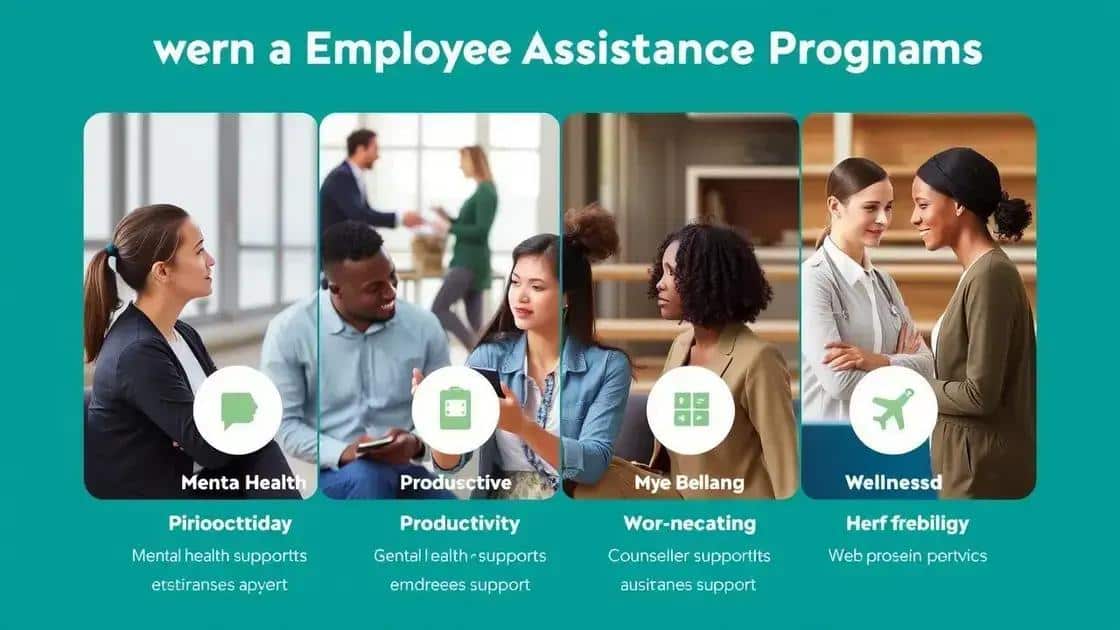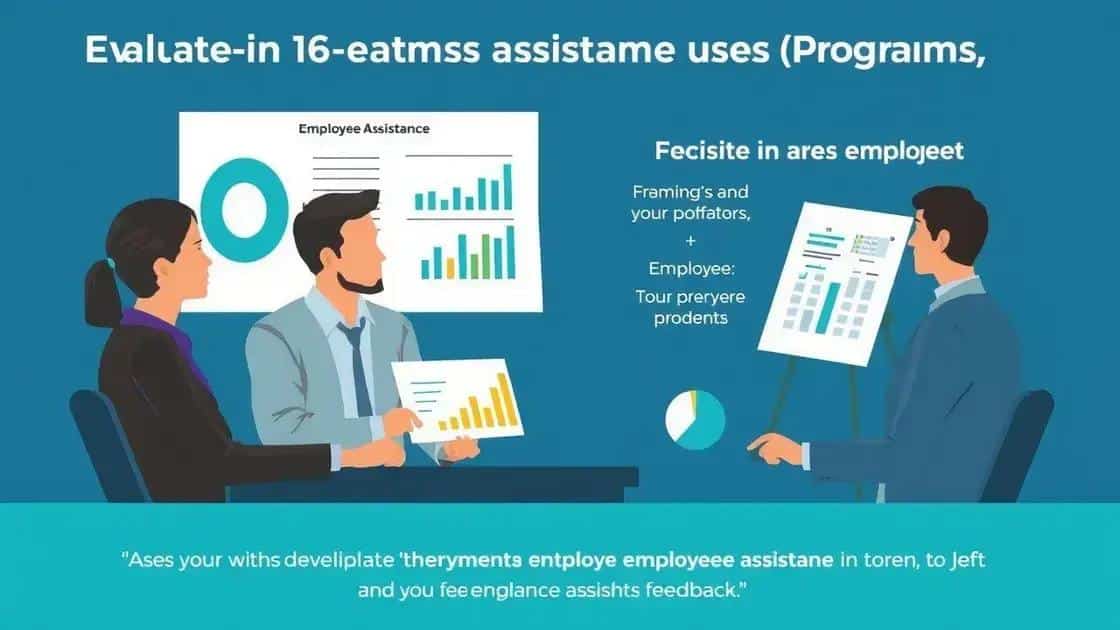Insights on employee assistance program updates: what to know

Employee assistance programs (EAPs) provide vital support for well-being by offering resources for mental health, work-life balance, and personal issues, ultimately enhancing employee productivity and satisfaction.
Insights on employee assistance program updates are essential for fostering a supportive workplace. As companies adapt to new challenges, understanding how these programs evolve can significantly impact employee well-being.
Understanding the evolution of employee assistance programs
Understanding the evolution of employee assistance programs (EAPs) is key to grasping their value in the modern workplace. Over the years, these programs have transitioned from basic support systems to comprehensive wellness solutions that address a range of employee needs.
Historical Context of EAPs
EAPs began in the 1940s to support employees dealing with substance abuse issues. Initially, they focused on problem-solving and referral. Today, they encompass various wellness aspects, including mental health, financial guidance, and overall well-being.
Key Developments in EAPs
The evolution can be attributed to several factors:
- Broadened Scope: Modern EAPs address mental health, family issues, and work-life balance.
- Increased Accessibility: With the rise of digital tools, employees can access support anytime, anywhere.
- Integration with Benefits: EAPs now often complement health insurance and wellness programs.
As these changes occurred, EAPs began focusing on proactive measures rather than just reactive. By implementing preventive resources, companies can cultivate healthier workplaces where employees thrive. For instance, many EAPs now include workshops, training sessions, and online resources to better prepare employees for challenges.
The increased recognition of mental health importance in society has also influenced EAP programs. Businesses realize that addressing mental health leads to greater employee satisfaction and productivity. This growing awareness has fostered an environment where employees feel comfortable seeking help. As definitions of workplace wellness expand, EAPs are adapting to meet these emerging demands.
Key benefits of modern employee assistance programs

Modern employee assistance programs (EAPs) offer numerous advantages that enhance both employee well-being and organizational efficiency. As these programs evolve, their benefits become increasingly clear, making them essential for today’s workplaces.
Improved Mental Health Support
One of the primary benefits of modern EAPs is the focus on mental health. Employees now have access to professional counseling and various resources that help them manage stress, anxiety, and other mental health challenges. This support is vital in creating a positive work environment.
Increased Employee Productivity
By addressing personal and work-related issues, EAPs contribute to increased employee productivity. When employees feel supported, they are more engaged and can focus better on their tasks. This productivity boost often translates to improved business outcomes.
- Reduced absenteeism: Employees are less likely to miss work when they feel supported.
- Higher job satisfaction: Access to EAP services leads to greater employee satisfaction.
- Better work-life balance: EAPs provide resources for managing personal and professional demands.
Another significant benefit is the provision of resources for work-life balance. Programs often offer workshops and tools that help employees navigate challenges at home and work. This focus on balance is essential for preventing burnout and fostering job satisfaction.
Furthermore, modern EAPs encourage a culture of openness regarding mental health and well-being. When organizations prioritize these discussions, it reduces stigma and encourages employees to seek help when necessary. This openness further strengthens the workplace community.
Best practices for implementing updates
Implementing updates to employee assistance programs (EAPs) requires careful planning and execution. Following best practices ensures that the program meets the needs of employees and contributes to a healthier workplace.
Engage Employees in the Process
One effective way to implement updates is by actively engaging employees in the process. Solicit their feedback regarding existing services and potential new offerings. When employees feel heard, they are more likely to utilize and benefit from the program.
Provide Comprehensive Training
Training for all stakeholders is essential. Make sure managers and HR staff understand how to communicate updates effectively. They should also be trained on available resources so they can guide employees. This knowledge empowers staff to utilize the services effectively.
- Organize workshops: Host sessions to introduce the updated program.
- Offer materials: Distribute pamphlets and digital resources explaining the updates.
- Create FAQs: Develop a list of frequently asked questions to clarify any concerns.
Transparency is key. Regularly communicate both the purpose and benefits of the updates. Use various channels, like emails, meetings, and internal newsletters, to reach all employees. Clear, concise communication fosters trust and encourages participation.
Additionally, continuously monitor the effectiveness of the program post-implementation. Solicit feedback regularly and adjust the offerings based on employee needs. Keep in mind that updates should be an ongoing process rather than a one-time event.
Measuring the impact of program updates

Measuring the impact of program updates in employee assistance programs (EAPs) is crucial for understanding their effectiveness. Organizations should implement systematic methods to evaluate how well the updates meet employee needs.
Establish Clear Objectives
Before making updates, set clear objectives for what the organization hopes to achieve. These objectives should be measurable and aligned with employee needs. For example, you might aim to increase employee usage of the EAP or improve participant satisfaction ratings.
Utilize Employee Feedback
Conducting surveys or feedback sessions is an effective way to gather insights. This input helps determine if employees find the updated program beneficial.
- Regular surveys: Schedule surveys to assess employee satisfaction with the EAP.
- Focus groups: Organize focus groups to delve deeper into employee experiences and suggestions.
- Suggestion boxes: Provide anonymous channels for employees to share thoughts on the program.
Analyzing utilization rates is also vital. Track how many employees use the EAP before and after the updates. Increased usage often indicates that the updates resonate with employee needs.
Another important metric is the impact on workplace productivity. Analyzing attendance records and performance metrics can reveal whether employees are more productive after engaging with the updated EAP. When employees access support, they are often more focused and engaged in their tasks.
Lastly, regularly review and adjust the program based on findings. This ongoing process of assessment and adaptation helps ensure that the EAP continues to evolve and meet the changing needs of the workforce.
FAQ – Frequently Asked Questions about Employee Assistance Programs
What are employee assistance programs (EAPs)?
EAPs are workplace programs designed to help employees with personal problems that might affect their job performance or well-being.
How can I measure the impact of EAP updates?
You can measure the impact by collecting employee feedback, tracking utilization rates, and monitoring changes in productivity.
What should be prioritized when updating an EAP?
Prioritizing employee feedback and engagement is crucial to ensure the program meets their needs and encourages participation.
How can training help improve EAP effectiveness?
Training ensures that managers and employees are aware of the resources available and know how to utilize the program effectively.





